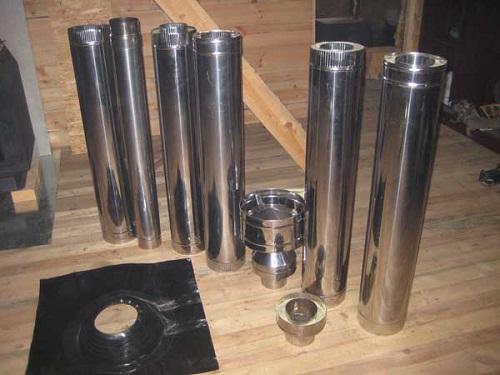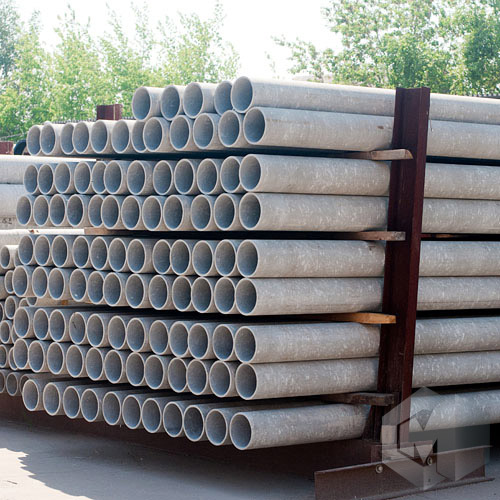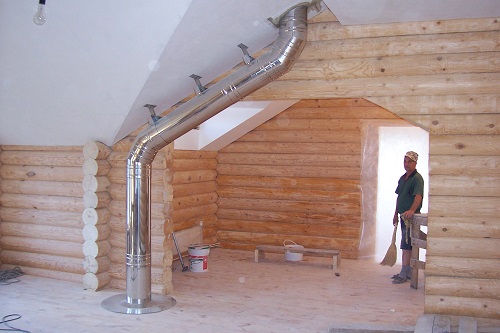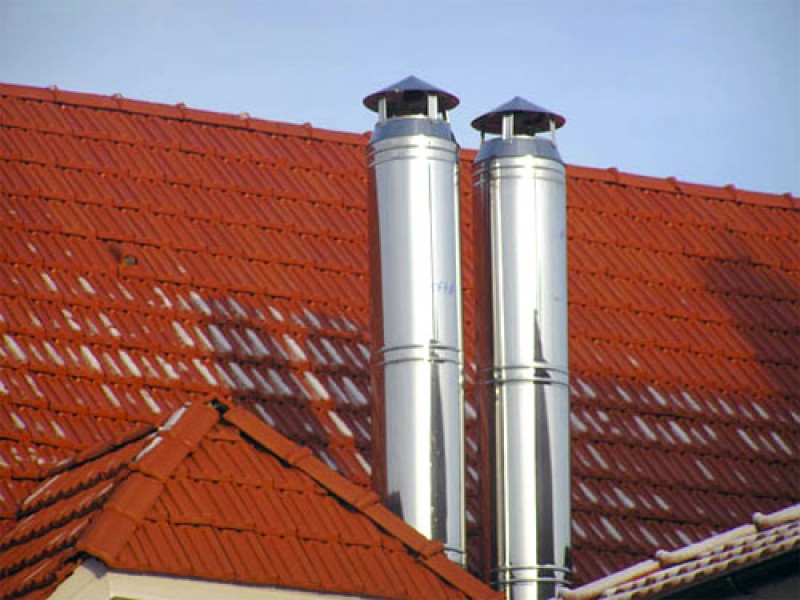If there is stove heating, it is logical to assume that there should be pipes for the chimney, through which the smoke will freely exit. Depending on how reliable the chimney will be, the security of your home will be so reliable, and choking from carbon monoxide, fire or other misfortunes will not affect your home.
From the intricacies of the installation of the chimney, as well as from its qualitative characteristics, not only the effective operation of the entire heating system will depend, but also the general safety of the entire house.
There are a huge number of offers on the market so that you can make a reliable chimney. Consider the main types of pipes that are used for chimneys, as well as the features of its structure. Chimneys for boilers and furnaces can be made of a variety of materials. In this case, not only familiar materials are used, such as steel, asbestos, brick, ceramics, but, sometimes, you can also find completely original structures made of glass and concrete. However, in our country they are not very common, and therefore in this article we will consider only their main types.
Content
Why do you need a chimney?
The answer to this question lies on the surface. Of course, it is needed in order to remove smoke and combustion products from the interior of the house. One of the most accurate may be the following definition: a chimney, so that there is natural draft, with which harmful combustion products would leave the chamber (furnace), and the incoming air could circulate freely.
The correct and safe installation of the chimney, as well as the selection of appropriate materials will guarantee the safety of not only the heated room, but also the entire heating system. However, many do not pay enough attention to the chimney system and do not always understand how important this system is in home improvement.
Sad statistics say this quite clearly. Russia, unfortunately, takes the first places “in the top” of the countries in which the greatest number of fires occurs. Often, this is due to the choice of poor-quality selection of materials for arranging the chimney, as well as to the neglect of safety measures, including fire safety.
Why is this happening? First of all, this may be the result of errors in the calculation of chimney pipes, as well as untimely maintenance of equipment. Chimneys, no matter how reliable they are, need to be periodically cleaned and take into account the fact that chimney pipes wear out over time.
Types and types of chimneys

Our distant ancestors were very lucky in that at the dawn of the development of civilization there was no need to think about which pipe to choose for the chimney, since life and life were quite simple. A man killed an animal, made a fire, and the smoke simply went into the hole above his head in their simple dwellings.
As time passed, heating systems improved, and as they developed, smoke from the stoves was removed through a series of special channels that were located in the walls, and later chimneys appeared.
As soon as people learned to burn clay, and a brick appeared, then for many centuries it became the only material for creating chimneys.
But progress cannot be stopped, and heating systems, over time, also began to undergo changes and were constantly improved. Increasingly, environmental issues and emissions of various harmful substances arise, and for this it is necessary to increase the efficiency of stoves and chimney designs so that there is less unnecessary waste and gas pollution.
As a consequence of all this, the requirements for the operational qualities of stoves, various fireplaces and boilers, as well as for the necessary rules for their operation and conditions of use, are increasing.
Today, chimneys must meet all basic requirements and be reliable in operation, have good quality characteristics, and also quite durable. They must be able to withstand fairly high temperature conditions from exposure to flue gases, resist condensation well, resist aggressive acids, if necessary, and fully comply with the main fire safety points.
Ceramic pipes, one solid advantage
What is a ceramic pipe for a chimney or a ceramic chimney? The chimney itself consists of several elements. The heat-resistant ceramic pipe, which is assembled from several sections, is enclosed in a shell of certain materials. Most often, such materials are stainless steel or expanded clay concrete.
Why do more and more people prefer ceramic chimneys? Here is a partial list of the main benefits:
- the possibility of quick and easy installation due to the modularity of the design;
- greater resistance to humidity;
- compliance with environmental safety standards;
- low aerodynamic drag characteristics;
- very long service life.
Why do ceramic pipes have a long service life? Yes, all because clay is the main material for their creation. And, as you know, burnt clay can serve for a very long time. It is enough to recall that archaeologists find clay shards that are several thousand years old, and at the same time they are in excellent condition!
From the point of view of environmental safety, they are also very reliable, since soot ignition in such pipes is excluded, which means that fire safety will be at a high level.
Here are some more positive characteristics in favor of choosing this particular type of chimney:
- pipes for a chimney made of ceramic are not only resistant to moisture, they are completely waterproof;
- another advantage is their high resistance to mechanical damage;
- A sharp change in temperature is also not afraid of them;
- such a characteristic as resistance to aggressive environments of acids and chemical reactions, in some cases, can exceed even steel pipes.
Ceramic chimney pipes, design features
Previously, the construction of brick chimneys required great efforts, not only physical, but also temporary. I had to take into account many characteristics during their construction, such as pipe fittings, calculation of the amount of materials, and so on.
Currently, you don’t have to worry about such things at all. Most often, pipes are manufactured shaped, which are supplied with special sockets and correspond to certain sizes. And for the greatest convenience in their installation, such pipes have special fasteners, with the help of which the pipe can be easily fixed to the wall.
If before the start of installation all the necessary calculations were done correctly, then at the final stage you only need to fold all the modules correctly in a certain sequence, and where there should be joints, carefully repair them.
For short, chimney systems that consist of several modules are called MDS. If the system runs on solid fuels such as wood or coal, then another abbreviation is added to this abbreviated name - TPK.In this case, such a chimney system will be called MDS-TPK.
Using such modules, you can use any type of fuel, from the most liquid to solid options. And in some cases, and combine them.
The advantage of such ceramic systems is that they due to their characteristics give good fire safety according to the European classification. In addition, they have good strength indicators, as well as low weight.
Asbestos chimney pipesIs it worth it to apply?

Asbestos-cement pipe for the chimney was most popular at a time when there was still such a state as the Soviet Union. Pipes were used not only in construction, but were also widely used in agriculture when caring for sown land.
Since the pipes had fairly low prices, they subsequently began to be used not only for agricultural purposes, but also used for chimneys, although initially such pipes were not intended for them.
What are the popularity and advantages of asbestos pipes?
Here are the main advantages that were considered very significant in the old days:
- huge reserves of such natural material as asbestos;
- a fairly simple pipe production technology;
- very low prices for this type of pipe (perhaps that they were the lowest on the whole planet);
- the tempting ability to use these pipes without any insulation.
It so happened that the owners of private houses, inspired by such attractive properties, began to use this type of pipe to create chimneys.
Are attacks on asbestos cement pipes justified?
What significant arguments can be made that would say that asbestos pipes should never be used? Many representatives of organizations that act as environmentalists have said and continue to say today that asbestos-cement pipes are harmful when used, that they emit carcinogens that are dangerous to the human body, and that their use in construction, and even more so in chimneys, is completely unacceptable.
But is the picture really so scary? The fact that a huge number of carcinogens is secreted by science is not confirmed in any way. In this sense, even asphalt emits much more harmful substances than pipes.
And therefore, this is not an essential argument not to use asbestos-cement pipes if chimneys are created for boilers or furnaces.
But there are some considerations that are still worth considering. It is believed that pipes made of asbestos cement are unable to withstand large temperature loads exceeding 300 degrees or more.
And this fact can be tried to challenge. After all, you can install this type of pipe not close to the boiler, where the most intense heating occurs, but at certain intervals. There, the temperature will ultimately be much lower than near the boiler. And this means that the use of such pipes is quite possible!
Probably, they could be used, if not for another, rather large drawback, which will be discussed later.
Forewarned is forearmed
No one will argue that the combustion process will result in the formation of a certain amount of soot. If the surface of the chimney is not smooth (which is exclusively true with asbestos cement pipes), then soot will settle and accumulate on the walls of the chimney, and this, ultimately, can cause a fire.
Of course, if ignition occurs, the temperature in the pipes made of asbestos cement can jump very much, which can lead to unpredictable consequences, even an explosion can occur.
For this reason, the use of asbestos-cement pipes in chimneys is not recommended. It is best not to take risks and prefer safer material.
Stainless Steel Modular Chimneys
Today's market trends are such that modular chimneys for boilers, stoves and fireplaces made of stainless steel become very popular. They have quite a few advantages. They are not as heavy as brick chimneys; they do not need an additional foundation for installation. There are also a number of advantages that significantly distinguish them among the "brothers." It can be said that this is practically an ideal chimney.

To begin with, let's carefully consider what a modular chimney consists of. For the manufacture of chimneys, high-quality steel and welding methods in an inert gas environment are used. The structure of such chimneys, as a rule, has an original name - such as “sandwich”.
The internal structure of such a chimney assumes the presence of several layers: special steel, a layer of thermal insulation, and a protective layer of metal on top (for example, of lower quality galvanized or stainless steel).

Austenitic steel of the 300th series (Aisi steel) is used for chimneys that require very high acid resistance, and for a less acidic environment, the 400th series of this type of steel can be used.
Consider the main advantages that a stainless pipe has for a chimney:
- unlimited possibilities of application in various fields (not only for the installation of chimney systems, but also for gas turbine or diesel plants);
- light weight greatly simplifies installation and subsequent installation of the entire system;
- the possibility of use in any regions of Russia (including in areas of seismic hazard);
- ease of maintenance of this type of chimney;
- the possibility, if necessary, of a partial or complete replacement of the chimney section (without replacing the entire system as a whole);
- excellent consumer characteristics;
- vapor and gas tightness;
- excellent fire safety features;
- durability of the material (not subject to corrosion);
- beautiful appearance allows you to create a modular type of the chimney, not only inside but also from the outside, which makes maintenance of the chimney easier.
But this is not all the main advantages of stainless steel chimneys. One of the main advantages of modular systems is that their design allows for assembly in parts, which means that they can be of any configuration that only the customer can think of.
It can be chimneys that will pass through numerous floors and walkways, have the most bizarre bends. You can realize any of your fantasies through the various modules of the entire system, mounting very complex chimneys for boilers, fireplaces and modern stoves.
Unlike asbestos-cement pipes, steel pipes have a smooth channel, which greatly simplifies the passage of gases from the pipes into the air, and due to the circular cross section of the pipe itself, the appearance of zones in which the gases will stagnate is practically eliminated, or such an unpleasant phenomenon as excessive soot deposits.
Of course, making a choice in favor of one or another chimney system is by no means an easy task. But if you make the right choice, then you will not have to regret about the wasted money, and the proper and reliable operation of the chimney system will serve as a guarantee of the safety of your home from fires and other troubles.





Alas, no comments yet. Be the first!